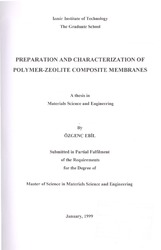Please use this identifier to cite or link to this item:
https://hdl.handle.net/11147/3883Full metadata record
| DC Field | Value | Language |
|---|---|---|
| dc.contributor.advisor | Çiftçioğlu, Muhsin | en |
| dc.contributor.author | Ebil, Özgenç | - |
| dc.date.accessioned | 2014-07-22T13:52:34Z | - |
| dc.date.available | 2014-07-22T13:52:34Z | - |
| dc.date.issued | 1999 | en |
| dc.identifier.uri | http://hdl.handle.net/11147/3883 | - |
| dc.description | Thesis (Master)--İzmir Institute of Technology, Materials Science and Engineering, İzmir, 1999 | en |
| dc.description | Includes bibliographical references (leaves: 85-88) | en |
| dc.description | Text in English; Abstract: Turkish and English | en |
| dc.description | 89 leaves | en |
| dc.description.abstract | This thesis is on the investigation of polymer-zeolite composite membranes for gas separation and the effects of a number of parameters such as solvent and zeolite type, zeolite content, polymer/solvent ratio and preparation temperature on the microstructure of the final membrane. Although there is an increasing interest in polymeric composite membranes, most of the previous work concentrated on the synthesis and performance measurements of new membrane materials rather than the effects of different methods and parameters on processmg.In this study polymer-zeolite composite membranes were prepared by a phase inversion technique. Polysulfone, natural zeolite and synthetic zeolite 13X were used as polymer and second phases respectively. Dichloromethane and dimethylformamide were used as solvents. Four experimental sets of membranes containing the same polymer but different solvents and zeolites with increasing zeolite loadings were prepared and characterized by thermo gravimetric analysis, infrared spectroscopy, optical microscopy and scanning electron microscopy.It has been found that the types of the solvent and zeolite directly affect the final microstructure of the membranes. Solvent removal rate and distribution of zeolite particles are important and have strong effects on the mechanical performance of the membranes.Membranes prepared by using synthetic zeolite 13X and dichloromethane were determined to be the best zeolite distributions in the microstructure by optical microscopy and thermogravimetric analysis. Uniform and mechanically strong membranes with 20-60 % synthetic zeolite contents were prepared. Mechanically weak and relatively nonuniform membranes were prepared by using natural zeolite clinoptilolite. The incorporation of an ultrasonic treatment of the zeolite dispersion most likely contributed in the successful deagglomeration of the second phase in the polymer matrix. | en |
| dc.language.iso | en | en_US |
| dc.publisher | 01. Izmir Institute of Technology | en |
| dc.rights | info:eu-repo/semantics/openAccess | en_US |
| dc.subject.lcc | TP159.M4 .E25 1999 | en |
| dc.subject.lcsh | Gas separation membranes | en |
| dc.subject.lcsh | Polymers | en |
| dc.subject.lcsh | Zeolites | en |
| dc.title | Preparation and characterization of polymer-zeolite composite membranes | en_US |
| dc.type | Master Thesis | en_US |
| dc.institutionauthor | Ebil, Özgenç | - |
| dc.department | Thesis (Master)--İzmir Institute of Technology, Materials Science and Engineering | en_US |
| dc.relation.publicationcategory | Tez | en_US |
| item.fulltext | With Fulltext | - |
| item.grantfulltext | open | - |
| item.languageiso639-1 | en | - |
| item.openairecristype | http://purl.org/coar/resource_type/c_18cf | - |
| item.cerifentitytype | Publications | - |
| item.openairetype | Master Thesis | - |
| crisitem.author.dept | 03.02. Department of Chemical Engineering | - |
| Appears in Collections: | Master Degree / Yüksek Lisans Tezleri | |
Files in This Item:
| File | Description | Size | Format | |
|---|---|---|---|---|
| T000056.PDF | MasterThesis | 15.76 MB | Adobe PDF |  View/Open |
CORE Recommender
Page view(s)
304
checked on Nov 18, 2024
Download(s)
100
checked on Nov 18, 2024
Google ScholarTM
Check
Items in GCRIS Repository are protected by copyright, with all rights reserved, unless otherwise indicated.